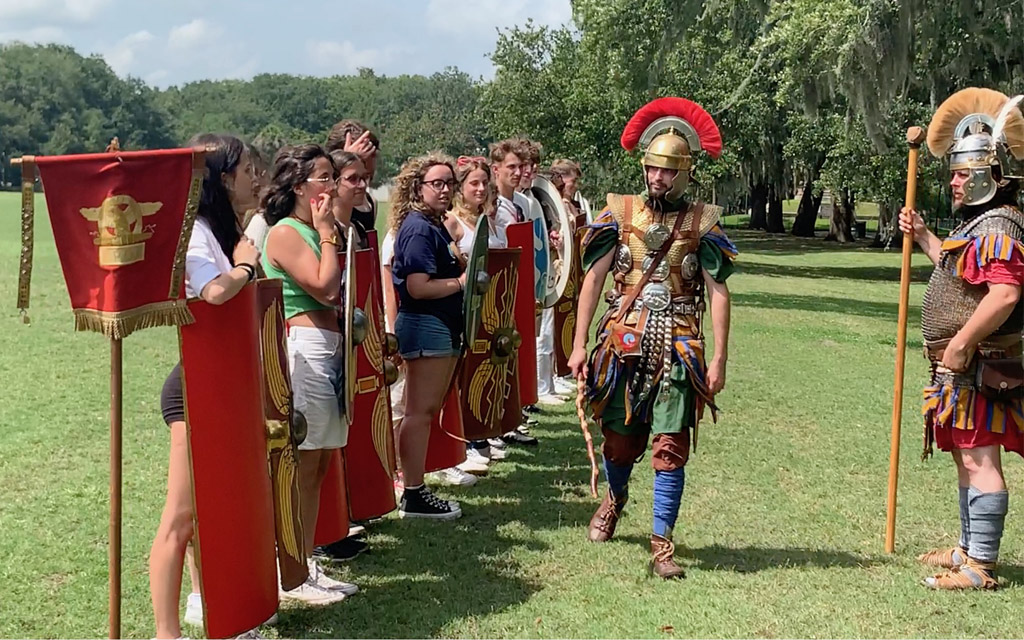Arma portate! Movetete!” commands Optio Marcus to 15 visiting high school students from various parts of the Veneto region of Italy. Notice that the Latin command for “forward march” reads a lot like “move it!”
Centurions Marcus and Septimius of Legion XIIII (aka Mark and Stephen Brennan from Savannah) have armed the students with authentic Roman shields in Forsyth Park on a baking day in June to practice ancient Roman drills and games. Even the large and colorful handmade shields cannot hide tank tops, sunglasses, and sneakers favored by twenty-first century 17-year-olds. However, their strong command of Latin, still taught in Italian middle schools, made them most obedient soldiers for the afternoon.

Septimius and Marcus made an appearance last fall at the Italian American Club of Hilton Head’s (IACHH) twelfth annual Italian Heritage Festival.
Septimius and Marcus made a surprise appearance last fall at the Italian American Club of Hilton Head’s (IACHH) twelfth annual Italian Heritage Festival, where they were an unqualified hit as they strolled the Honey Horn grounds in full kit, drawing out the paparazzo in everyone with a smartphone.
Yet, no one had seen them before, so did they step out of a time machine?
It turns out the Brennan brothers are part of a large membership known as Roman Legio XIIII Gemina Martia Victrix. Translated, it means Legion Fourteen, a consolidation of centurion armies following the civil wars with Pompey and the death of Julius Caesar, when the Roman soldiers were brought together under one commander, Augustus (Octavian) Caesar. Gemina is the consolidation part. Martia Victrix (martial victory) commemorates “Boudicca’s Rebellion,” in 60 AD, when the legion famously defeated the last British rebellion until 410.
According to their website, the modern-day incarnation was founded in 2015 as a “historical re-enactment and living history organization based in the United States, [that] seeks to recreate the equipment, routines, and the experiences of Roman Legionaries from the first century AD for public, private and educational events.”
Membership groups can be found in Argentina, Poland, Italy, and Spain. But most are concentrated in the United States in the north and southeast, from Michigan, to Pennsylvania and New England, down through Virginia, Kentucky, the Carolinas, and into Texas, with the core of the original group still in Ohio.
The groups get together and practice drills and fighting techniques. Their code of gear and dress is very strict and abides by a detailed handbook that explains exactly what they can wear and when they can move up in rank and armor. The handbook comes with pictures of clothing and weaponry, including photos of authentic relics found for comparison. Cloth for tunics, and paint for shields must be dyed naturally in the manner that ancient craftsmen employed to perform their tasks. Instructions are given and references to experts who specialize in plant-dyed cloth and hand-carved shields.
“Our aim is to represent the Roman military as it really was—historically correct,” said Brian Hicks, retired Marine, and former Civil War reenactor. Hicks maintains the website and represents an evocatus in the Legion. An evocatus was a retired centurion who had re-enlisted as a consultant and sometimes participated in battles. Valued for his military expertise, Hicks wears the phalerae (medals) of an accomplished warrior and helps educate new members and audiences about the reenactments.
“The movies and TV don’t always depict soldiers accurately regarding armor, weapons, titles, and protocols. We try to present the most honest version of our military forebears as we can, based on original artifacts and writings that have been authenticated and deciphered through the years,” Hicks said.
Indeed, Stephen and Mark Brennan truly know their stuff and aren’t shy about setting people straight about Roman history and politics. To outfit oneself appropriately according to the 240-page handbook requires dedication and a thorough reading along with a good source for ancient military speak, as everything needed—from kit to weaponry—is described in Latin, with no modern-day explanation.
The Brennans’ fascination with Roman history began with video games Rome Total War and Rome Settlers. Next, of course, they dressed up for Halloween as centurions. Identifying with soldiers from the past is as much about education and history as it is about the battlefield. Mark claims he’s more interested in the politics of the time, while Stephen is curious about the warfare and hierarchy.
So, what do the Legions reenact? Their largest events are known as historical timeline events, in which battle reenactors representing other eras set up their own encampments in a famous battlefield like the upcoming Marching Through Time in Jamestown. Groups from the Roman Legion era and medieval to the Revolutionary War, 1812, and Civil War demonstrate strategies, battles, and weaponry from their own time of warfare. Tables are set up with ancient Roman board games, and others serving authentic Roman meals.
This year, you can see a Legio XIIII Gemina historical reenactment at the thirteenth annual Italian Heritage Festival, presented by the IACHH, October 21, at the Coastal Discovery Museum at Honey Horn. The Brothers Brennan will recreate Roman drills, routines, and games at their own encampment for festival attendees. Everyone is welcome for a day of games, entertainment, crafts, food, and a silent auction.
The IACHH is a non-profit service organization, 501(c)(3), promoting Italian heritage/culture, while raising and distributing funds to local scholarships and charitable organizations in the Hilton Head Island and Bluffton areas of South Carolina.

